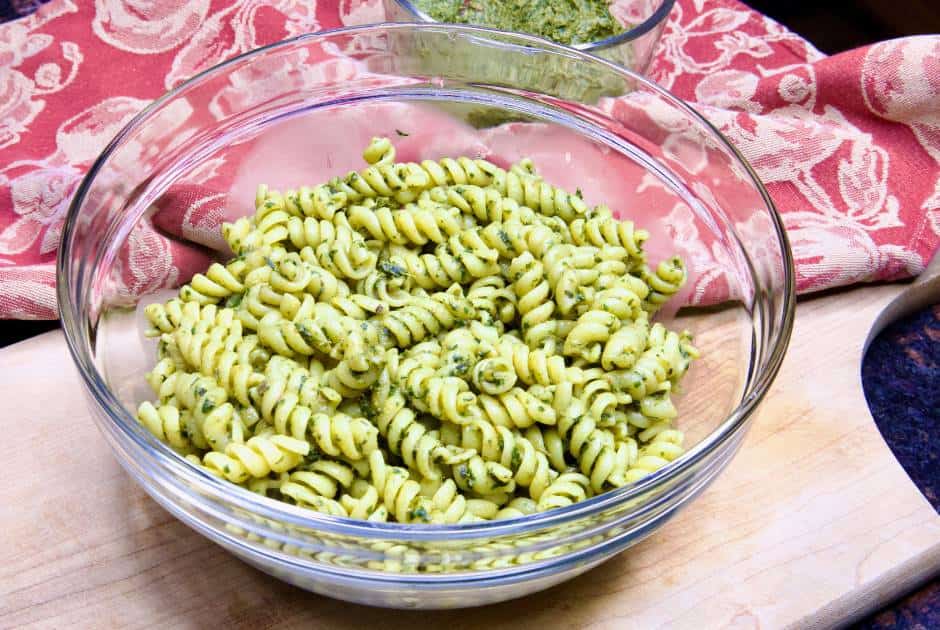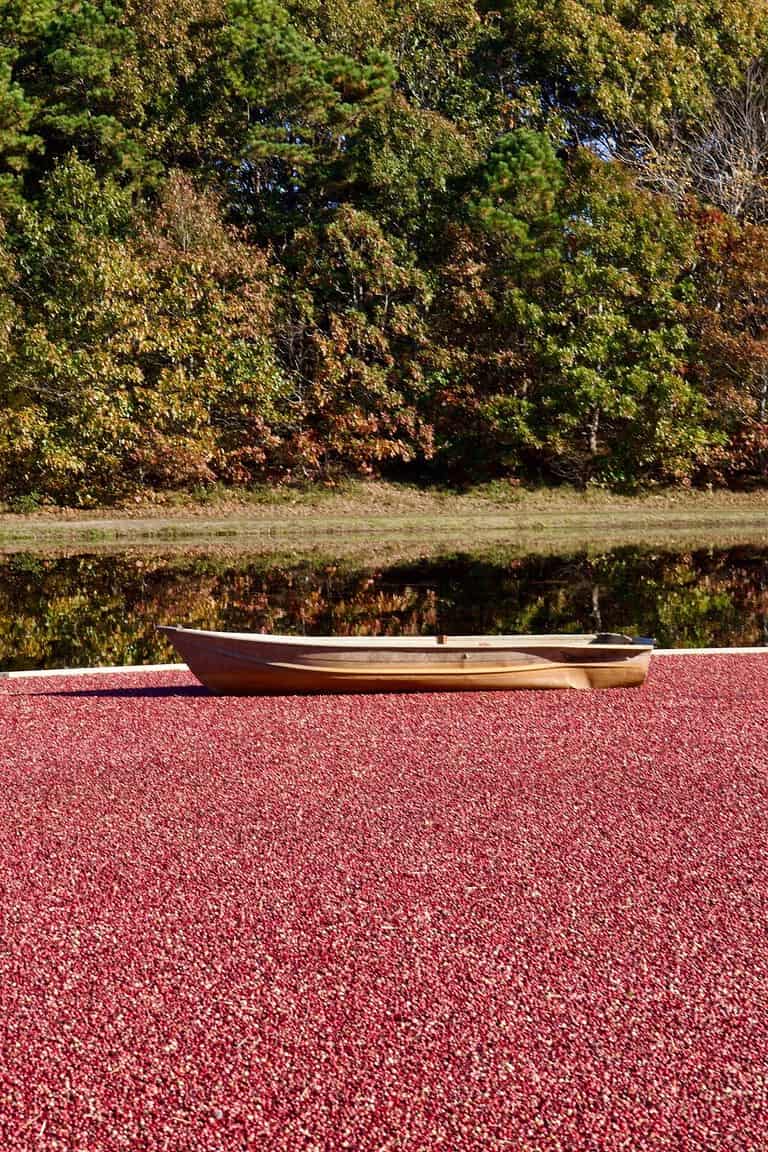No-Oil Lemon Pesto Pasta: Your New Favorite Recipe
This No-Oil Lemon Pesto Pasta is a guilt-free, health-conscious twist to traditional pesto. Enjoy delicious vibrant flavors without compromising your well-being.

Although I adore a fresh classic pesto sauce, this no-oil lemon pesto pasta recipe offers a subtle deviation from traditional pesto. The infusion of zesty lemon and bright pesto introduces a refreshing and health-conscious twist to a beloved classic.
Pesto originated in Genoa, Italy but it is believed that back in ancient Roman times they ate a similar paste called “moretum”, which was made by crushing together garlic, cheese, and fresh herbs, and then mixing that with olive oil and vinegar.
Pesto in Italy is called Pesto alla genovese, and in proper English, Genoese pesto (1).
This article may contain affiliate links for your convenience. Also, as an Amazon Associate, I earn from qualifying purchases at no extra cost to you. You can read the full disclosure policy.
5 Reasons To Try No-Oil Lemon Pesto Pasta
- Healthy: This fresh pesto sauce is incredibly healthy because it uses fresh ingredients and nothing processed, including no oil. When you add this sauce to organic pasta or even whole-grain pasta, you have yourself an easy dinner filled with lots of nutrients and fiber.
- A Versatile Condiment: pesto is a wonderful and versatile condiment that can be used not just on pasta but as a sandwich spread, in soups, and as a dressing for a leafy green salad. Pesto can be as versatile as you are creative!
- Refreshing Variation: This lemony citrus pesto serves as a refreshing variation to the heavier traditional pesto sauce. Don’t get me wrong, I love pesto in any form but this lemony variety is a vibrant and refreshing alternative, especially during the spring and summertime months.
- Quick and Simple: this easy pesto recipe is a snap to make. Many people think making homemade pesto pasta is hard but it’s not at all. Plus, when you make it from scratch, you are better able to control the ingredients, so you can make a very healthy version.
- Satisfying: This No-Oil Lemon Pesto Pasta is deliciously satisfying without giving you that heavy bloated feeling you might experience after eating a pesto that contains a lot of saturated fat from cheese and oil. I find after eating this I have lots of energy without the crash afterward.
No-Oil Lemon Pesto Pasta Ingredients
LEMON PESTO SAUCE INGREDIENTS
Fresh basil: Because you will use quite a bit of basil, it is best to look for large fresh bunches versus those little plastic boxes that you see in the grocery store.
Fresh arugula: The same goes for arugula. Look for large fresh bunches of bright and crisp arugula.

Fresh garlic: I like to use fresh garlic cloves but if all you have is jarred minced garlic, that will work too.
Pine Nuts (optional): Pine nuts are an optional ingredient but I love the nutty flavor this brings to the lemon pesto. So if you do not have a nut allergy, I highly recommend using pine nuts.
Sundried tomatoes: To make this recipe 100% oil-free, look for sundried tomatoes that are stored in water rather than oil.
Tahini: In my book, tahini is a completely underrated ingredient. Tahini in this recipe gives this lemon pesto a beautifully distinct and in-depth flavor.
Miso Paste: I love to use miso paste as a substitute for salt. You get a nutrition boost without the sodium hit when using miso paste.
Apple Cider Vinegar: Apple Cider Vinegar helps maintain the brightness of this recipe and adds a distinct citrus, tangy flavor.
Lemon Juice: The key ingredient for this recipe so look for the best, most fresh, lemons you can find.
Lemon Zest: Adding lemon zest to any citrus-like recipe makes all of the difference. Using a microplane, aka lemon zester, works well but if you do not have one, feel free to use a vegetable peeler instead. Don’t skip this ingredient if possible.
Red Pepper Flakes: Just a pinch will do ya, for that extra tiny kick.

PASTA INGREDIENTS
Fusilli pasta: Fusilli pasta is the best pasta for pesto sauce because the sauce can get in all of the nooks and crannies, which helps you get a true taste of pesto with every bite you take.
Nutritional yeast (optional): Nutritional yeast is my go-to ingredient when I want to add a bit of a cheesy flavor to a dish without eating dairy and consuming a lot of saturated fat. A good quality nutritional yeast is fortified with nutrients, including B vitamins. (2).
Kosher salt and black pepper (optional): Use according to your taste preference.
Vegan parmesan cheese (optional): Many vegan cheeses are very high in saturated fat, and I wouldn’t call them a healthy food but If you are desiring a hint of that cheesy flavor, and nutritional yeast isn’t enough, then try a good quality vegan parmesan cheese but do so sparingly to keep this dish as healthy as possible.
Kitchen Tools To Consider
large pot – this is a wonderful set of pots and pans. My daughters gave me a set as a housewarming gift when I purchased my home on Cape Cod, and I have never looked back. They are so easy to work with, non-toxic, provide even heating, and are just plain beautiful.
Food Processor – having a good food processor makes food preparation go that much quicker in the kitchen, however, if you do not have a food processor, you can easily use a blender too.
measuring cups I like these measuring cups because they are made of natural wood and are non-toxic.
measuring spoons – these measuring spoons are also made of natural wood and match the measuring cups.
silicone spatula – or you can also use a wooden spoon.
microplane (aka lemon zester) – great for grating the skin of a lemon or orange.
glass storage container – I like to use glass to store any leftover food items. With a tightly sealed lid, they help to keep your food fresh.
No-Oil Lemon Pesto Pasta Step-By-Step Instructions
LEMON PESTO SAUCE INSTRUCTIONS
Add pine nuts to the food processor and pulse 3-5 times to break down the nuts into fine pieces.
Next, add the basil and arugula and pulse again to break down the leafy greens.

Add the tahini, miso, apple cider vinegar, lemon juice, lemon zest, and red pepper flakes. Blend on medium speed until smooth and creamy. Make sure to scrape down the sides as necessary.
If need be, add additional water or lemon juice, using 1 tablespoon at a time, until the lemon pesto is smooth and creamy and forms a thick paste.
PASTA INSTRUCTIONS
Fill a large pot with filtered water and set it on the stove on high heat until the water comes to a rapid boil.
Add the pasta and let the water return to a boil.
Set the pot on medium-low heat and cook uncovered, stirring occasionally for approximately 10 minutes, or until tender – al dente pasta.
Next, drain the pasta into a colander, rinse if desired, and drain well.
PUTTING IT ALL TOGETHER
Add 1 large dollop, approximately 1/2 cup, of lemon pesto to the bottom of the large pot.
Once the pasta has been drained, pour it back into the pot.
Add another large dollop of lemon pesto to the top of the pasta, and stir until all of the lemon pesto sauce is combined and coated evenly onto the pasta.
Next, season according to your taste. Add nutritional yeast, vegan parmesan cheese, additional lemon juice if you like a stronger lemon flavor, and salt and pepper to taste.
Stir everything to combine and serve.
ENJOY!

Tips For Success
When you are blending the lemon pesto, if you do not feel like it is creamy enough, feel free to add, 1 tablespoon at a time. either water or lemon juice, if you want that super tangy lemony flavor.
Most of the time I end up adding just a little bit, approximately 1-2 tablespoons more, but it all depends on the basil and arugula ratio as well as your taste preference.
Feel free to use whole wheat pasta, or gluten-free pasta if you desire. And to make this pasta dish completely grain-free, use spaghetti squash instead of regular pasta – yum!
The pine nuts are optional but if you do not have a nut allergy, I highly recommend you use them, as they give the sauce a little deeper and rich nutty flavor. You can also use walnuts in place of pine nuts if you wish.

Meyer lemons have amazing juice and flavor. If you can find them I would say go for it! They are slightly more expensive than regular lemons but well worth it. Especially for this lemon pesto sauce.
Lemon zest is a great addition to this delicious pesto sauce. For best results be careful not to also include the bitter white pith, as this will disrupt the citrus flavor.
This recipe is made oil-free but if you wish, you can always use just a touch of extra-virgin olive oil to smooth out this fresh basil pesto and pasta dish.
Nutritional yeast works beautifully in this pasta dish as a cheesy substitute that has plenty of B vitamins. Whenever I am looking for a bit of a cheesy flavor, I grab the nutritional yeast.
For a delicious variation, consider adding some delicious roasted vegetables to this pasta dish.
How To Store
If you do not use all of the homemade pesto, feel free to store it in the fridge in an airtight container.
The lemony pesto will last in the fridge for approximately 6-7 days.
For longer storage, think about making this zesty lemon pesto recipe, scooping the pesto into ice cube trays, and then placing it in the freezer. This is a great way to separate the pesto so you can make smaller portions down the road.
More Healthy Recipes And Caregiver Support
Let’s Connect
I hope you try this No-Oil Lemon Pesto Pasta, and I hope you like it so much that you share it with your friends and family.
Please consider giving this pasta recipe a 5-star rating and comment below. I would love to hear from you.
Printable Recipe Card For You To Enjoy
Equipment
- silicone spatula – or wooden spoon
- microplane – aka lemon zester
Ingredients
Lemon Pesto Sauce Ingredients
- 2 cups fresh basil
- 2 cups fresh arugula
- 2 cloves garlic – minced
- 2 tbsp pine nuts (optional)
- 2 medium sundried tomatoes – or 1/4C julienned sundried tomatoes
- 1 tbsp raw tahini
- 1 tbsp yellow miso paste – preferably organic
- 1 tbsp apple cider vinegar
- 2 tbsp lemon juice – keep remaining to add later if needed.
- 1/2 tsp lemon zest
- pinch red pepper flakes
Pasta Ingredients
- 1 lb fusilli pasta – approx. 16oz
- 1/4 cup nutritional yeast – optional
- kosher salt & black pepper – to taste
- vegan parmesan cheese – to taste
Instructions
Lemon Pesto Sauce Instruction
- Add pine nuts to the food processor and pulse 3-5 times to break down the nuts to fine pieces.
- Add the basil and arugula and pulse again to break down the leafy greens.
- Add the tahini, miso, apple cider vinegar, lemon juice, and red pepper flakes. Blend on medium speed until smooth and creamy.Make sure to scrape down the sides as necessary.
- If need be, add additional water or lemon juice, using 1 tablespoon at a time, until the lemon pesto is smooth and creamy and forms a thick paste.
Pasta Instructions
- Fill a large pot with filtered water and set it on the stove on high heat until the water comes to a rapid boil.
- Add the pasta and let the water return to a boil.
- Set the pot on medium heat and cook uncovered, stirring occasionally for approximately 10 minutes, or until the pasta is al dente – just tender.
- Next, drain the pasta into a colander, rinse if desired, and drain well.
Putting It All Together
- Add 1 large dollop, approximately 1/2 cup, of lemon pesto to the bottom of the large pot.
- Once the pasta has been drained, pour it back into the pot.
- Add another large dollop of lemon pesto to the top of the pasta, and stir until all of the lemon pesto sauce is combined and coated evenly onto the pasta.
- Next, season according to your taste. Add nutritional yeast, vegan parmesan cheese, additional lemon juice if you like your pasta super tangy, and salt and pepper to taste.
- Stir everything to combine and serve.
- ENJOY!
Notes
- When you are blending the lemon pesto, if you do not feel like it is creamy enough feel free to add, 1 tablespoon at a time. either water or lemon juice if you want that super tangy lemony flavor.
- Most of the time I end up adding approximately 1-2 tablespoons more but it all depends on the basil and arugula ratio as well as your taste preference.
- Feel free to use whole wheat pasta or gluten-free pasta if you desire.
- The pine nuts are optional but if you do not have a nut allergy, I highly recommend you use them, as they give the sauce a little deeper and rich nutty flavor.
- You can also use walnuts in place of pine nuts if you wish.
- Meyer lemons have amazing juice and flavor. If you can find them I would say go for it! They are slightly more expensive than regular lemons but well worth it. Especially for this lemon pesto sauce.
- Lemon zest is a great addition to the lemon pesto sauce if you desire.
- This recipe is made oil-free but if you wish, you can always use a touch of extra-virgin olive oil to smooth out this fresh basil pesto and pasta dish.
- Nutritional yeast works beautifully in this pasta dish as a cheesy substitute that has plenty of B vitamins. Whenever I am looking for a bit of a cheesy flavor, I grab the nutritional yeast.
- If you do not use all of the homemade pesto, feel free to store it in the fridge in an airtight container.
- The lemony pesto will last in the fridge for approximately 6-7 days.
- For longer storage, think about making this zesty lemon pesto recipe, scooping the pesto into ice cube trays, and then placing it in the freezer. This is a great way to separate the pesto so you can make smaller portions down the road.
Nutrition
Reference
- https://en.wikipedia.org/wiki/Pesto
- https://plantbasednews.org/lifestyle/food/what-is-nutritional-yeast/




